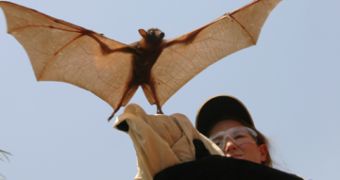We, humans, have in our retina two types of photoreceptor cells: the cones for daylight vision and color vision, and the more sensitive rods for night vision.
This is also the case with most mammals.
But nocturnal bats were traditionally believed to have just rods. Bats are assigned to two evolutionary groups (which many believe to have different origins): lesser bats (Microchiroptera) and Old World fruit bats or greater bats (Megachiroptera).
The names are somehow misleading as the largest Microchiroptera can be larger than smaller Megachiroptera, even if some Megachiroptera - such as flying foxes (Pteropus species) - can be enormous (for the bat standard).
Microbats do echolocate, but Megachiroptera does not (except for the genus Rousettus). Moreover, Megachiroptera have large eyes, developed brain visual centers (Microchiroptera have developed auditory centers). Flying foxes often employ exposed treetops as daytime roosts, where they form large colonies.
Greater bats forage at night for nectar and fruit, using visual and olfactory clues.
While navigating to the foraging grounds at dusk and the return to the daytime roost at dawn, the animals employ just vision, and on moonless nights, they cannot fly so they remain hungry. Visual navigation at twilight and occasionally during the daytime made researchers challenge the old concept that fruit bats only possess rods for night vision.
Cone cells would have helped the bats in spotting predators and for social interactions at roost during the daytime.
A team made of Brigitte M?ller and Leo Peichl at the Max Planck Institute for Brain Research in Frankfurt and Steven Goodman at The Field Museum for Natural History in Chicago has found that nocturnal fruit bats (flying foxes) do possess cones in addition to rods. The team stained the retinas of various fruit bat species with visual pigment-specific antibodies, to detect photoreceptor cells types.
Cone photoreceptors made about 0.5 % of the photoreceptor cells. "This share of cones appears small, but from studies of other night-active mammals we know that it allows daylight vision", said M?ller. Cats and dogs have 2-4 % cones, and humans, with highly developed diurnal vision just 5 % cones. "The retina of flying foxes is no 'evolutionary quirk', but conforms to the general mammalian blueprint that comprises rods and cones", said M?ller.
Flying fox species have been found to possess two spectral cone types, blue cones that track short-wave light, and green cones for middle-to-long-wave light.
This dichromatic color vision is one of the most common mammalian conditions (human, monkeys, birds have trichromatic vision, having also red cones). The retinas of other three studied genera of Megachiroptera: Rousettus (rousette fruit bat), Eidolon (straw colored fruit bat), and Epomophorus (epauleted fruit bat) lacked the blue cones, possessing just green cones. "With just one cone type, spectral discriminations are not possible, so these species must be color blind. A loss of blue cones is a rare event in evolution, it has been found in only a few mammals." said Peichl.
This was linked to the behavior of these bats. Flying foxes (Pteropus) roost in large open treetops, where they are exposed to birds of prey, as their too big to employ tree hollows or small caves (these bats can reach 1.8 m (6 ft) in wingspan and 1 kg (2.5 pounds) in weight). That's why they need visual 'early warning' to survive. "Furthermore, flying foxes don't sleep all day; they often change their positions in the tree and interact with their neighbors. Young flying foxes also make training flights during the day. All these daytime activities require visual capabilities", said M?ller.
In contrast, much smaller Rousettus roosts in caves (that's why they need echolocation, as there is total darkness), and Epomophorus in the darkest parts of large trees, explaining their somewhat smaller eyes, lower cone densities, and no color vision. "In our outdoor enclosures, flying foxes roost openly during daytime, whereas the other genera retreat to darkened sleeping cubicles", said Dana LeBlanc of the Lubee Bat Conservancy in Florida.
Still, while searching for food at night, the bats rely on the more sensitive rods that convey no color information. Cones are used more in twilight and dawn light navigation.

 14 DAY TRIAL //
14 DAY TRIAL //